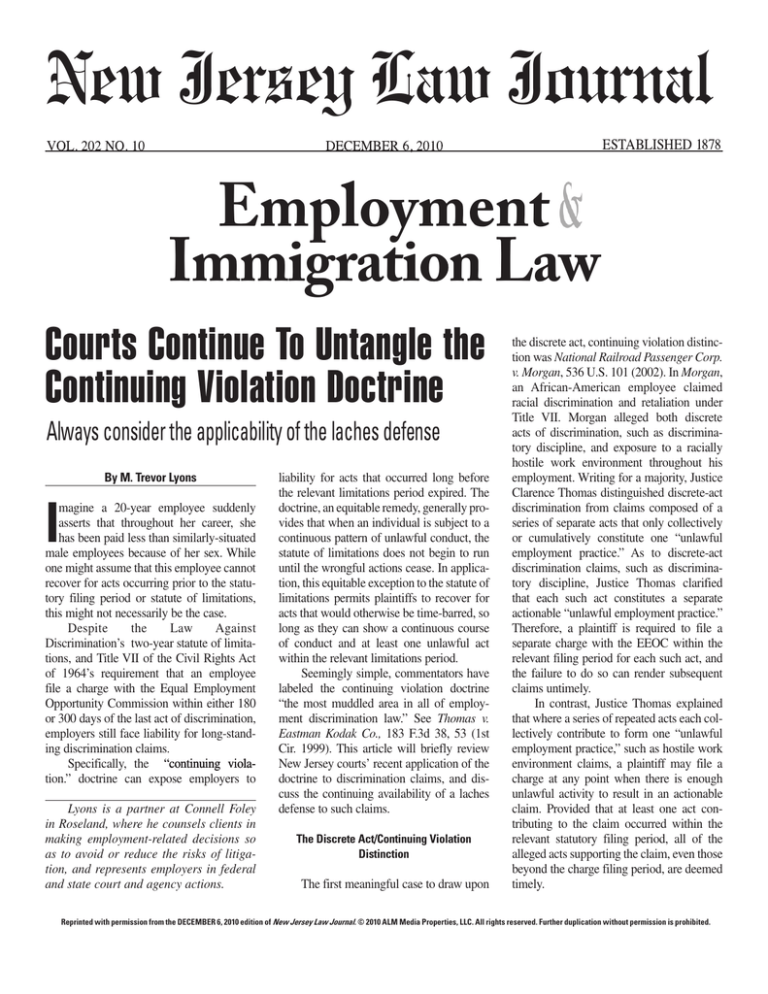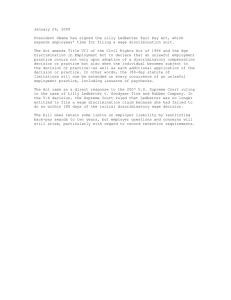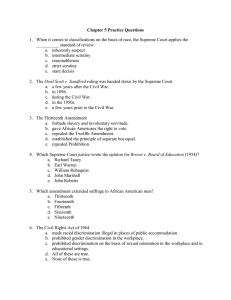
New Jersey Law Journal
VOL. 202 NO. 10
ESTABLISHED 1878
December 6, 2010
Employment
Immigration Law
Courts Continue To Untangle the
Continuing Violation Doctrine
Always consider the applicability of the laches defense
By M. Trevor Lyons
I
magine a 20-year employee suddenly
asserts that throughout her career, she
has been paid less than similarly-situated
male employees because of her sex. While
one might assume that this employee cannot
recover for acts occurring prior to the statutory filing period or statute of limitations,
this might not necessarily be the case.
Despite
the
Law
Against
Discrimination’s two-year statute of limitations, and Title VII of the Civil Rights Act
of 1964’s requirement that an employee
file a charge with the Equal Employment
Opportunity Commission within either 180
or 300 days of the last act of discrimination,
employers still face liability for long-standing discrimination claims.
Specifically, the � ������������������
“�����������������
continuing violation.” doctrine can expose employers to
Lyons is a partner at Connell Foley
in Roseland, where he counsels clients in
making employment-related decisions so
as to avoid or reduce the risks of litigation, and represents employers in federal
and state court and agency actions.
liability for acts that occurred long before
the relevant limitations period expired. The
doctrine, an equitable remedy, generally provides that when an individual is subject to a
continuous pattern of unlawful conduct, the
statute of limitations does not begin to run
until the wrongful actions cease. In application, this equitable exception to the statute of
limitations permits plaintiffs to recover for
acts that would otherwise be time-barred, so
long as they can show a continuous course
of conduct and at least one unlawful act
within the relevant limitations period.
Seemingly simple, commentators have
labeled the continuing violation doctrine
“the most muddled area in all of employment discrimination law.” See Thomas v.
Eastman Kodak Co., 183 F.3d 38, 53 (1st
Cir. 1999). This article will briefly review
New Jersey courts’ recent application of the
doctrine to discrimination claims, and discuss the continuing availability of a laches
defense to such claims.
The Discrete Act/Continuing Violation
Distinction
The first meaningful case to draw upon
the discrete act, continuing violation distinction was National Railroad Passenger Corp.
v. Morgan, 536 U.S. 101 (2002). In Morgan,
an African-American employee claimed
racial discrimination and retaliation under
Title VII. Morgan alleged both discrete
acts of discrimination, such as discriminatory discipline, and exposure to a racially
hostile work environment throughout his
employment. Writing for a majority, Justice
Clarence Thomas distinguished discrete-act
discrimination from claims composed of a
series of separate acts that only collectively
or cumulatively constitute one “unlawful
employment practice.” As to discrete-act
discrimination claims, such as discriminatory discipline, Justice Thomas clarified
that each such act constitutes a separate
actionable “unlawful employment practice.”
Therefore, a plaintiff is required to file a
separate charge with the EEOC within the
relevant filing period for each such act, and
the failure to do so can render subsequent
claims untimely.
In contrast, Justice Thomas explained
that where a series of repeated acts each collectively contribute to form one “unlawful
employment practice,” such as hostile work
environment claims, a plaintiff may file a
charge at any point when there is enough
unlawful activity to result in an actionable
claim. Provided that at least one act contributing to the claim occurred within the
relevant statutory filing period, all of the
alleged acts supporting the claim, even those
beyond the charge filing period, are deemed
timely.
Reprinted with permission from the DECEMBER 6, 2010 edition of New Jersey Law Journal. © 2010 ALM Media Properties, LLC. All rights reserved. Further duplication without permission is prohibited.
2
NEW JERSEY LAW JOURNAL, DECEMBER 6, 2010
Because the LAD’s statute of limitation
employs decidedly different language than
Title VII’s administrative filing requirement,
it was not clear whether New Jersey would
follow Morgan’s reasoning. Any uncertainty,
however, was resolved later that same year
in Shepherd v. Hunterdon Developmental
Center, 174 N.J. 1 (2002).
In Shepherd, two plaintiffs alleged that
they had been subjected to a continuous pattern of ill-treatment after they supported a
co-worker’s discrimination lawsuit, and they
asserted, among other things, hostile work
environment claims. Defendants sought dismissal, arguing that plaintiffs’ claims were
time barred because they had known that they
were discriminated against when they sent
a detailed letter about their claims to their
superintendent two years and 26 days before
they filed their complaint.
Despite noting that federal precedent is
only a guide for LAD claims, Justice Peter
Verniero, writing for the majority, explained
there was a benefit in having New Jersey law
“mirror the approach taken in Morgan to
avoid further confusion in an already complicated area of law.” As result, New Jersey’s
Supreme Court expressly adopted Morgan’s
distinction between discrete act and continuing course of conduct discrimination for
LAD claims. Applying that analytical framework, Justice Verniero found that because the
plaintiffs had identified one timely act, and
had asserted a continuing course of conduct
which included that timely act, their claims
were timely.
More recently, in Roa v. LAFE, 200 N.J.
555 (2010), New Jersey’s Supreme Court
again spoke to discrete act and continuing
violation claims. In Roa, a couple alleged that
the husband’s firing and the termination of
his insurance coverage was unlawful retaliation for his reporting of sexual harassment.
These events had occurred more than two
years before plaintiffs filed their complaint,
but Roa alleged that he had only received
notice of the coverage termination within
the relevant limitations period, and that his
discovery less than two years before initiating
his lawsuit, rendering his claim as to this act
timely. He also argued that his retaliatory discharge claim was part of the same pattern of
conduct, and was therefore also timely under
the continuing violation doctrine.
The Supreme Court disagreed, holding
that the doctrine does not permit the aggregation of discrete discriminatory acts to revive
an untimely act that the victim knew or should
have known was actionable. Specifically, the
Supreme Court explained that when Roa
was fired, he clearly knew, or should have
known, he had been the subject of retaliation.
Therefore, the Court held that Roa should
have filed his unlawful termination claim
within two years of that date. When he did
not do so, that claim was lost.
Discriminatory Pay Claims and the LAD
In Ledbetter v. Goodyear Tire & Rubber
Co., 550 U.S. 618 (2007), the United State
Supreme Court held that employers cannot
be sued under Title VII for unequal and discriminatory pay, if such claims are based on
decisions made beyond the relevant charge
filing period. Specifically, Lilly Ledbetter
worked for Goodyear from 1979 until 1998.
Although initially paid the same as her male
colleagues, she asserted that over the years
she was progressively paid less than similarly
situated males, and that by 1997, her male
colleagues received 15 percent to 40 percent
more than her. She brought suit alleging sex
discrimination. The Supreme Court held that
“she could have, and should have, sued”
when the relevant pay decisions were made,
instead of waiting well beyond the statutory
charging period. The effect of this decision,
however, was reversed by the 2009 passage
of theLilly Ledbetter Fair Pay Act, amending
Title VII so that the charge-filing period for a
discriminatory pay claim resets with receipt
of each new paycheck.
Following the passage of the Ledbetter
Act, the question arose regarding how New
Jersey’s courts would treat discriminatory pay
claims. In Alexander v. Seton Hall University,
410 N.J. Super. 574 (App. Div. 2009), the
Appellate Division held that a plaintiff cannot
assert a continuing violation claim based on
wages received during the limitations period,
if the difference in pay is the result of a discrete pay decision occurring before the limitations period. Essentially, without action by
the legislature, the Appellate Division chose
to follow the decision in Ledbetter, despite
the latter passage of the Ledbetter Act. The
New Jersey Supreme Court, however, granted certification in this case this year.
Don’t Forget About Laches
The state Supreme Court, however,
granted certification in this case this year,
202 N.J.L.J. 826
and on Nov. 23, rejected the Appellate
Division’s adoption of the U.S. Supreme
Court’s Ledbetter decision. Instead, Justice
LaVecchia, writing for the majority, explained
that each payment of unequal wages by an
employer constitutes an actionable wrong
that is remediable under the LAD, but that
the LAD’s two-year statute of limitations
applies to such violations by cutting off the
untimely portion of such claims. Therefore,
the Supreme Court held that the plaintiffs’
claims were not time-barred, but that they
could only recover for wages paid for the two
years prior to the filing of their complaint.
Clearly, courts are struggling with the
inequity of permitting a less than diligent
employee to assert a continuing-violation
claim potentially exposing an employer
to a disproportionate back pay award, and
the difficulty of having to defend against a
stale claim.
As recognized by Justice Verniero in
Shepherd, the risk for potential injustice
attendant to the prosecution of such stale
claims is much greater in the employment
discrimination context than in almost all
other types of claims. This is because credibility typically plays such a crucial element
in these cases, and evidence of discrimination is uniquely vulnerable to the passage
of time. As a result, New Jersey courts have
readily supported a laches defense when
an employee unreasonably delays bringing a claim, and that delay prejudices the
employer’s ability to defend itself.
For example, in Mancini v. Township
of Teaneck, 179 N.J. 425 (2004), a police
officer alleged that she had been subjected
to a hostile work environment and retaliation since 1981. Despite holding that a
laches defense had been waived in that
case, the Supreme Court confirmed the
availability of laches as a defense to the
stale prosecution of discrimination claims.
Generally, Justice Verniero identified the
following factors as especially relevant to
the defense: (1) whether an alleged act is
unreasonably distant in time; (2) whether
a plaintiff knew or should have known
of a valid claim based on that act; and
(3) whether the plaintiff’s delay in filing
a claim has caused undue prejudice to a
defendant.
Therefore, an employer facing a continuing-violation claim based upon an event
in the distant past should always consider
the applicability of a laches defense. ■





